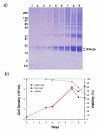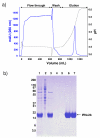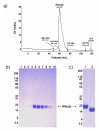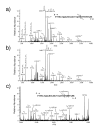Stable high volumetric production of glycosylated human recombinant IFNalpha2b in HEK293 cells
- PMID: 18752669
- PMCID: PMC2538527
- DOI: 10.1186/1472-6750-8-65
Stable high volumetric production of glycosylated human recombinant IFNalpha2b in HEK293 cells
Abstract
Background: Mammalian cells are becoming the prevailing expression system for the production of recombinant proteins because of their capacity for proper protein folding, assembly, and post-translational modifications. These systems currently allow high volumetric production of monoclonal recombinant antibodies in the range of grams per litre. However their use for large-scale expression of cytokines typically results in much lower volumetric productivity.
Results: We have engineered a HEK293 cell clone for high level production of human recombinant glycosylated IFNalpha2b and developed a rapid and efficient method for its purification. This clone steadily produces more than 200 mg (up to 333 mg) of human recombinant IFNalpha2b per liter of serum-free culture, which can be purified by a single-step cation-exchange chromatography following media acidification and clarification. This rapid procedure yields 98% pure IFNalpha2b with a recovery greater than 70%. Purified IFNalpha2b migrates on SDS-PAGE as two species, a major 21 kDa band and a minor 19 kDa band. N-terminal sequences of both forms are identical and correspond to the expected mature protein. Purified IFNalpha2b elutes at neutral pH as a single peak with an apparent molecular weight of 44,000 Da as determined by size-exclusion chromatography. The presence of intramolecular and absence of intermolecular disulfide bridges is evidenced by the fact that non-reduced IFNalpha2b has a greater electrophoretic mobility than the reduced form. Treatment of purified IFNalpha2b with neuraminidase followed by O-glycosidase both increases electrophoretic mobility, indicating the presence of sialylated O-linked glycan. A detailed analysis of glycosylation by mass spectroscopy identifies disialylated and monosialylated forms as the major constituents of purified IFNalpha2b. Electron transfer dissociation (ETD) shows that the glycans are linked to the expected threonine at position 106. Other minor glycosylated forms and non-sialylated species are also detected, similar to IFNalpha2b produced naturally by lymphocytes. Further, the HEK293-produced IFNalpha2b is biologically active as shown with reporter gene and antiviral assays.
Conclusion: These results show that the HEK293 cell line is an efficient and valuable host for the production of biologically active and glycosylated human IFNalpha2b.
Figures








Similar articles
-
Disruption of Pichia pastoris PMR1 gene decreases its folding capacity on human serum albumin and interferon-alpha2b fusion protein.Yeast. 2008 Apr;25(4):279-86. doi: 10.1002/yea.1589. Yeast. 2008. PMID: 18350526
-
Altering the central carbon metabolism of HEK293 cells: Impact on recombinant glycoprotein quality.J Biotechnol. 2017 Jan 20;242:73-82. doi: 10.1016/j.jbiotec.2016.12.003. Epub 2016 Dec 7. J Biotechnol. 2017. PMID: 27940295
-
Construction, expression and characterization of human interferon alpha2b-(G4S)n-thymosin alpha1 fusion proteins in Pichia pastoris.World J Gastroenterol. 2005 May 7;11(17):2597-602. doi: 10.3748/wjg.v11.i17.2597. World J Gastroenterol. 2005. PMID: 15849818 Free PMC article.
-
Glycosylation control technologies for recombinant therapeutic proteins.Appl Microbiol Biotechnol. 2018 Dec;102(24):10457-10468. doi: 10.1007/s00253-018-9430-6. Epub 2018 Oct 17. Appl Microbiol Biotechnol. 2018. PMID: 30334089 Review.
-
Production of recombinant protein therapeutics in cultivated mammalian cells.Nat Biotechnol. 2004 Nov;22(11):1393-8. doi: 10.1038/nbt1026. Nat Biotechnol. 2004. PMID: 15529164 Review.
Cited by
-
A human expression system based on HEK293 for the stable production of recombinant erythropoietin.Sci Rep. 2019 Nov 14;9(1):16768. doi: 10.1038/s41598-019-53391-z. Sci Rep. 2019. PMID: 31727983 Free PMC article.
-
A panel of recombinant proteins from human-infective Plasmodium species for serological surveillance.Malar J. 2020 Jan 17;19(1):31. doi: 10.1186/s12936-020-3111-5. Malar J. 2020. PMID: 31952523 Free PMC article.
-
A library of recombinant Babesia microti cell surface and secreted proteins for diagnostics discovery and reverse vaccinology.Int J Parasitol. 2019 Feb;49(2):115-125. doi: 10.1016/j.ijpara.2018.10.003. Epub 2018 Oct 24. Int J Parasitol. 2019. PMID: 30367868 Free PMC article.
-
Expression of recombinant antibodies.Front Immunol. 2013 Jul 29;4:217. doi: 10.3389/fimmu.2013.00217. eCollection 2013. Front Immunol. 2013. PMID: 23908655 Free PMC article.
-
Liver-targeting of interferon-alpha with tissue-specific domain antibodies.PLoS One. 2013;8(2):e57263. doi: 10.1371/journal.pone.0057263. Epub 2013 Feb 25. PLoS One. 2013. PMID: 23451195 Free PMC article.
References
-
- Kaluz S, Kabat P, Gibadulinova A, Vojtassak J, Fuchsberger N, Kontsek P. Interferon alpha2b is the predominant subvariant detected in human genomic DNAs. Acta Virol. 1994;38:101–104. - PubMed
-
- Gewert DR, Sharp NA, Barber KA, Cooper H, Tucker D, Lewis AP, Thursz M, Crowe JS. Detection of rare allelic variants of the interferon-alpha 2 gene in human genomic DNA. J Interferon Cytokine Res. 1995;15:403–406. - PubMed
MeSH terms
Substances
LinkOut - more resources
Full Text Sources
Other Literature Sources

